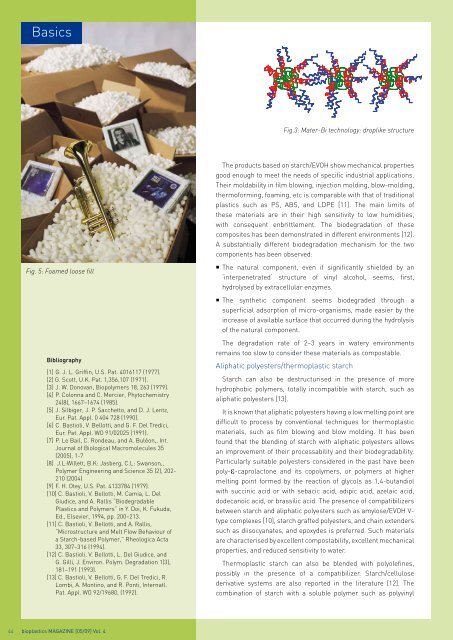bioplasticsMAGAZINE_0905
bioplasticsMAGAZINE_0905
bioplasticsMAGAZINE_0905
You also want an ePaper? Increase the reach of your titles
YUMPU automatically turns print PDFs into web optimized ePapers that Google loves.
Basics<br />
Fig.3: Mater-Bi technology: droplike structure<br />
The products based on starch/EVOH show mechanical properties<br />
good enough to meet the needs of specific industrial applications.<br />
Their moldability in film blowing, injection molding, blow-molding,<br />
thermoforming, foaming, etc is comparable with that of traditional<br />
plastics such as PS, ABS, and LDPE [11]. The main limits of<br />
these materials are in their high sensitivity to low humidities,<br />
with consequent enbrittlement. The biodegradation of these<br />
composites has been demonstrated in different environments [12].<br />
A substantially different biodegradation mechanism for the two<br />
components has been observed:<br />
Fig. 5: Foamed loose fill<br />
Bibliography<br />
[1] G. J. L. Griffin, U.S. Pat. 4016117 (1977).<br />
[2] G. Scott, U.K. Pat. 1,356,107 (1971).<br />
[3] J. W. Donovan, Biopolymers 18, 263 (1979).<br />
[4] P. Colonna and C. Mercier, Phytochemistry<br />
24(8), 1667–1674 (1985).<br />
[5] J. Silbiger, J. P. Sacchetto, and D. J. Lentz,<br />
Eur. Pat. Appl. 0 404 728 (1990).<br />
[6] C. Bastioli, V. Bellotti, and G. F. Del Tredici,<br />
Eur. Pat. Appl. WO 91/02025 (1991).<br />
[7] P. Le Bail, C. Rondeau, and A. Buléon,, Int.<br />
Journal of Biological Macromolecules 35<br />
(2005), 1-7<br />
[8] J.L:Willett, B.K: Jasberg, C.L: Swanson,,<br />
Polymer Engineering and Science 35 (2), 202-<br />
210 (2004)<br />
[9] F. H. Otey, U.S. Pat. 4133784 (1979).<br />
[10] C. Bastioli, V. Bellotti, M. Camia, L. Del<br />
Giudice, and A. Rallis “Biodegradable<br />
Plastics and Polymers” in Y. Doi, K. Fukuda,<br />
Ed., Elsevier, 1994, pp. 200–213.<br />
[11] C. Bastioli, V. Bellotti, and A. Rallis,<br />
“Microstructure and Melt Flow Behaviour of<br />
a Starch-based Polymer,” Rheologica Acta<br />
33, 307–316 (1994).<br />
[12] C. Bastioli, V. Bellotti, L. Del Giudice, and<br />
G. Gilli, J. Environ. Polym. Degradation 1(3),<br />
181–191 (1993).<br />
[13] C. Bastioli, V. Bellotti, G. F. Del Tredici, R.<br />
Lombi, A. Montino, and R. Ponti, Internatl.<br />
Pat. Appl. WO 92/19680, (1992).<br />
• The natural component, even if significantly shielded by an<br />
‘interpenetrated‘ structure of vinyl alcohol, seems, first,<br />
hydrolysed by extracellular enzymes.<br />
• The synthetic component seems biodegraded through a<br />
superficial adsorption of micro-organisms, made easier by the<br />
increase of available surface that occurred during the hydrolysis<br />
of the natural component.<br />
The degradation rate of 2–3 years in watery environments<br />
remains too slow to consider these materials as compostable.<br />
Aliphatic polyesters/thermoplastic starch<br />
Starch can also be destructurised in the presence of more<br />
hydrophobic polymers, totally incompatible with starch, such as<br />
aliphatic polyesters [13].<br />
It is known that aliphatic polyesters having a low melting point are<br />
difficult to process by conventional techniques for thermoplastic<br />
materials, such as film blowing and blow molding. It has been<br />
found that the blending of starch with aliphatic polyesters allows<br />
an improvement of their processability and their biodegradability.<br />
Particularly suitable polyesters considered in the past have been<br />
poly-e-caprolactone and its copolymers, or polymers at higher<br />
melting point formed by the reaction of glycols as 1,4-butandiol<br />
with succinic acid or with sebacic acid, adipic acid, azelaic acid,<br />
dodecanoic acid, or brassilic acid. The presence of compatibilizers<br />
between starch and aliphatic polyesters such as amylose/EVOH V-<br />
type complexes [10], starch grafted polyesters, and chain extenders<br />
such as diisocyanates, and epoxydes is preferred. Such materials<br />
are characterised by excellent compostability, excellent mechanical<br />
properties, and reduced sensitivity to water.<br />
Thermoplastic starch can also be blended with polyolefines,<br />
possibly in the presence of a compatibilizer. Starch/cellulose<br />
derivative systems are also reported in the literature [12]. The<br />
combination of starch with a soluble polymer such as polyvinyl<br />
44 bioplastics MAGAZINE [05/09] Vol. 4


















